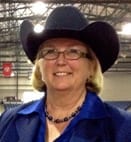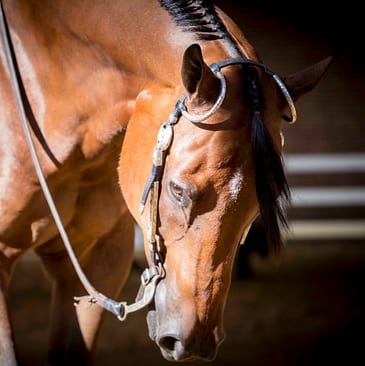To say that over the years, horses’ headsets in the western pleasure classes have been a major issue, is an understatement. Those same concerns have now entered the arena in the pattern classes. AQHA has tried to address the issue in the pattern classes with Rule SW437.2.
According to the 2014 AQHA Rulebook, Rule SW437.2 states that it is a Major Fault in the regular pattern classes if the horse’s head is:
Head carried too high
Head carried too low (tip of ear below withers)
Over flexing or straining neck in head carriage so the nose is carried behind the vertical
Excessive nosing out
GoHorseShow asked judges and trainers their thoughts on this rule. It is stated in the rulebook that an excellent rider with a major fault will be knocked down from the 90-100 range to the 70-79 range. That being said, some judges are more forgiving and not as “offended” as others with regard to headsets in the pattern classes. While some judges will bury some competitors due to what they believe are offensive headsets, others are more apt to see past the issue or give the horse and rider the benefit of the doubt.
We want to know your opinions on this issue. Should it be a major fault if a horse appears too overbridled, intimidated or overdone? Read the comments of several trainers and judges below and let us know your thoughts.
 Brad Jewett–I do not think that a horse that is over bridled should immediately be hit with a major or minor fault. It’s how the horse is being ridden that should be judged. Some horses are conformationally going to appear more over bridled. That doesn’t mean those horses are abused or intimidated. I think as judges we have to look for riders that know how to ride a horse in a manner that keeps the horse in a collected manner. There is so much more than judging a headset. True horsemanship is about feel and precision. I have seen many horses overdone, and I think it’s obvious when that horse shows to me. I have also seen horses come in that look soft and collected that does not give me the feeling that the horse is intimidated. There are so many good trainers out there that can train horses with many buttons. There are not as many trainers out there who can actually coach a rider to communicate to a horse in a way so that the horse likes to do his/her job. As trainers sometimes, we put horses through things or longe them to death so the horse will put up with the rider’s mistakes instead of teaching the rider to become a better rider. I guess what I’m saying is as judges we should be able to tell the difference. I’m afraid that being over bridled will sometimes leave out some very good riders.
Brad Jewett–I do not think that a horse that is over bridled should immediately be hit with a major or minor fault. It’s how the horse is being ridden that should be judged. Some horses are conformationally going to appear more over bridled. That doesn’t mean those horses are abused or intimidated. I think as judges we have to look for riders that know how to ride a horse in a manner that keeps the horse in a collected manner. There is so much more than judging a headset. True horsemanship is about feel and precision. I have seen many horses overdone, and I think it’s obvious when that horse shows to me. I have also seen horses come in that look soft and collected that does not give me the feeling that the horse is intimidated. There are so many good trainers out there that can train horses with many buttons. There are not as many trainers out there who can actually coach a rider to communicate to a horse in a way so that the horse likes to do his/her job. As trainers sometimes, we put horses through things or longe them to death so the horse will put up with the rider’s mistakes instead of teaching the rider to become a better rider. I guess what I’m saying is as judges we should be able to tell the difference. I’m afraid that being over bridled will sometimes leave out some very good riders.
 Margo Ball–It has been a known fact for many years that in AQHA competition (as well as other breed associations) that the industry is very influenced by trends. Often times the trends become so excessive that we lose sight of the purpose and the ideal of the class. Our rulebook serves as the guideline for showing and judging our horses and provides an excellent description of the purpose and ideals of the classes. The problems arise when there is a discrepancy between the rules and guidelines and their interpretation. With that said, I have seen a trend in the equitation and the horsemanship where the horse’s headset and head carriage is less than ideal according to the rulebook. In order to correct this trend, the faults concerning the horse’s head carriage have been changed to a major fault. I agree with this change. This is one way that we can adhere to the standards as well as the purpose of the class. I do offer a word of caution on this subject of head carriage and rules concerning the performance of the horse in horsemanship and equitation. The ultimate purpose of this class is to judge the equitation/horsemanship ability of the rider. Equitation/Horsemanship can be defined the art or practice of riding a horse. This includes maintaining a correct position and using effective and subtle aids and cues to control the horse. The horse’s performance is a reflection of the rider’s ability for the most part. A rider that is effective in their use of aids, cues and correct body position should be getting the best performances on their horses. There should be no need for extremes in any part of the performance. Examples of extremes would be over bridled, intimidated, overdone and many times horses that are simply over ridden in the patterns in an effort to “stand out”. The bottom line is that we as judges, trainers, and exhibitors be on the same page as far the rules and guidelines and adhere to those rules not our individual interpretations. This is how some of our negative trends get started.
Margo Ball–It has been a known fact for many years that in AQHA competition (as well as other breed associations) that the industry is very influenced by trends. Often times the trends become so excessive that we lose sight of the purpose and the ideal of the class. Our rulebook serves as the guideline for showing and judging our horses and provides an excellent description of the purpose and ideals of the classes. The problems arise when there is a discrepancy between the rules and guidelines and their interpretation. With that said, I have seen a trend in the equitation and the horsemanship where the horse’s headset and head carriage is less than ideal according to the rulebook. In order to correct this trend, the faults concerning the horse’s head carriage have been changed to a major fault. I agree with this change. This is one way that we can adhere to the standards as well as the purpose of the class. I do offer a word of caution on this subject of head carriage and rules concerning the performance of the horse in horsemanship and equitation. The ultimate purpose of this class is to judge the equitation/horsemanship ability of the rider. Equitation/Horsemanship can be defined the art or practice of riding a horse. This includes maintaining a correct position and using effective and subtle aids and cues to control the horse. The horse’s performance is a reflection of the rider’s ability for the most part. A rider that is effective in their use of aids, cues and correct body position should be getting the best performances on their horses. There should be no need for extremes in any part of the performance. Examples of extremes would be over bridled, intimidated, overdone and many times horses that are simply over ridden in the patterns in an effort to “stand out”. The bottom line is that we as judges, trainers, and exhibitors be on the same page as far the rules and guidelines and adhere to those rules not our individual interpretations. This is how some of our negative trends get started.
 Robin Frid–People need to remember that horsemanship is really a prerequisite for reining. When judging the reining, we are not judging on style. Horses have different conformation and will have a different look according to the way they are built. In order for horses to be able to do athletic maneuvers that are required for many classes including the horsemanship, the horse must use their back and it must be lifted up. When their back is lifted, their neck will drop. Look at the hunter horses–when they jump a fence–their back is rounded and their head drops lower than their withers. Are horses’ heads sometimes too low in the pattern classes? Yes, they are! Do I sometimes get them too low, yes! But there is a reason–some horses, especially young horses, need extra help to get through the maneuvers. When judging, I am not going to kill a horse that is slightly behind the vertical or their head is below their withers. I like to see a rider ride the horse into their hand–I don’t think we want everyone to have a loose rein and have all them trained to spur stop. If I find a rider showing their horse with an offensive headset, then I hurt them. But I don’t think as judges we need to be told what is offensive. It appears we are taking all the subjectivity out of judging. I don’t think it is smart or good for the industry to have the same winners. Judging is a matter of judgement. I believe the equitation and the horsemanship involves the rider’s ability to communicate to the horse and that horse’s ability to accept that communication. While headsets of the horses should be taken into consideration; it is not the most important aspect in my mind, and, if the best rider rides their horse with their head slightly below level, then I will still let them win.
Robin Frid–People need to remember that horsemanship is really a prerequisite for reining. When judging the reining, we are not judging on style. Horses have different conformation and will have a different look according to the way they are built. In order for horses to be able to do athletic maneuvers that are required for many classes including the horsemanship, the horse must use their back and it must be lifted up. When their back is lifted, their neck will drop. Look at the hunter horses–when they jump a fence–their back is rounded and their head drops lower than their withers. Are horses’ heads sometimes too low in the pattern classes? Yes, they are! Do I sometimes get them too low, yes! But there is a reason–some horses, especially young horses, need extra help to get through the maneuvers. When judging, I am not going to kill a horse that is slightly behind the vertical or their head is below their withers. I like to see a rider ride the horse into their hand–I don’t think we want everyone to have a loose rein and have all them trained to spur stop. If I find a rider showing their horse with an offensive headset, then I hurt them. But I don’t think as judges we need to be told what is offensive. It appears we are taking all the subjectivity out of judging. I don’t think it is smart or good for the industry to have the same winners. Judging is a matter of judgement. I believe the equitation and the horsemanship involves the rider’s ability to communicate to the horse and that horse’s ability to accept that communication. While headsets of the horses should be taken into consideration; it is not the most important aspect in my mind, and, if the best rider rides their horse with their head slightly below level, then I will still let them win.
 Jan Hoskins Hay–I agree with rule SW437.2 being a major fault. Especially over flexing or straining neck in head carriage, nose behind the vertical – it is a very undesirable appearance in the show pen and should be more than a minor fault; I feel it borders on the line of intimidation. We see riders that try to be the “over achiever” when preparing their horse at the show, and probably always will. Now with the scoring system for the pattern classes, it gives judges a place to assess a fault and evaluation for each maneuver for the horse that is presented to them with an “overdone” appearance. Outside, our AQHA Stewards and Professional Horseman are doing great work at keeping the “over achievers” in check. We are seeing pattern classes that are highly competitive for both youth and amateur. I feel the judging for these events has advanced in part due to the scoring system and the accountability of it.
Jan Hoskins Hay–I agree with rule SW437.2 being a major fault. Especially over flexing or straining neck in head carriage, nose behind the vertical – it is a very undesirable appearance in the show pen and should be more than a minor fault; I feel it borders on the line of intimidation. We see riders that try to be the “over achiever” when preparing their horse at the show, and probably always will. Now with the scoring system for the pattern classes, it gives judges a place to assess a fault and evaluation for each maneuver for the horse that is presented to them with an “overdone” appearance. Outside, our AQHA Stewards and Professional Horseman are doing great work at keeping the “over achievers” in check. We are seeing pattern classes that are highly competitive for both youth and amateur. I feel the judging for these events has advanced in part due to the scoring system and the accountability of it.
 Gayle Lampinen–I don’t have a problem supporting this rule for the pattern classes. Most classes sort themselves out by the level of riders. I have found riders experiencing these faults are happening for many reasons–mainly ineffective riders caused by lack of legs, seat and too much hand. Personally I’m hard on riders who present their horses behind the vertical in an intimidated manner. I see this more in trail where riders are trying to get a handle on their horse to perform an obstacle. It’s very hard for me to zero the maneuver when a horse is presented in this manner. Usually for me, it’s a minus half maneuver. Overall, I feel exhibitors have been great and are truly showing their horses to the best of their ability in accordance to the rules.
Gayle Lampinen–I don’t have a problem supporting this rule for the pattern classes. Most classes sort themselves out by the level of riders. I have found riders experiencing these faults are happening for many reasons–mainly ineffective riders caused by lack of legs, seat and too much hand. Personally I’m hard on riders who present their horses behind the vertical in an intimidated manner. I see this more in trail where riders are trying to get a handle on their horse to perform an obstacle. It’s very hard for me to zero the maneuver when a horse is presented in this manner. Usually for me, it’s a minus half maneuver. Overall, I feel exhibitors have been great and are truly showing their horses to the best of their ability in accordance to the rules.
 Bonnie Miller— As a judge, I believe that part of horsemanship is showing your horse correctly at all gaits. A horse that is over bridled or intimidated is not going to do the gaits correctly and the pattern will lack the positive qualities of cadence, rhythm, smoothness and efficiency. Most judges I work with have opened the patterns up to encourage forward movement. Personally, I like to use patterns that incorporate an extension at the jog or lope. I also try to use transitions from the lope to the walk instead of the lope to the stop to encourage smoothness and flow within the pattern. I want to reward the rider who executes the pattern with precision and smoothness. The horse that carries his head too high, or too low, or is straining with the nose behind the vertical will exhibit negative characteristics in his movement which will, in turn, negatively impact the score on the pattern. I have not witnessed any major problems with how the horses are prepared for the pattern classes. The negative characteristics result in a lower pattern score. As an AQHA judge I am compelled to follow the guidelines that the rulebook dictates. A minor or major fault is noted on the horsemanship scoresheet and is excellent feedback to the exhibitor. Personally I add comments, both positive and negative when possible. For example, if a rider was exhibiting his horse incorrectly I may comment: “poor quality lope” if I felt the rider’s presentation at the lope did not allow the horse to lope correctly, not if the horse was a poor mover. All horses have an optimum pace where they look best at the gait; the best rider will know what that pace is and show their horse to its best ability.
Bonnie Miller— As a judge, I believe that part of horsemanship is showing your horse correctly at all gaits. A horse that is over bridled or intimidated is not going to do the gaits correctly and the pattern will lack the positive qualities of cadence, rhythm, smoothness and efficiency. Most judges I work with have opened the patterns up to encourage forward movement. Personally, I like to use patterns that incorporate an extension at the jog or lope. I also try to use transitions from the lope to the walk instead of the lope to the stop to encourage smoothness and flow within the pattern. I want to reward the rider who executes the pattern with precision and smoothness. The horse that carries his head too high, or too low, or is straining with the nose behind the vertical will exhibit negative characteristics in his movement which will, in turn, negatively impact the score on the pattern. I have not witnessed any major problems with how the horses are prepared for the pattern classes. The negative characteristics result in a lower pattern score. As an AQHA judge I am compelled to follow the guidelines that the rulebook dictates. A minor or major fault is noted on the horsemanship scoresheet and is excellent feedback to the exhibitor. Personally I add comments, both positive and negative when possible. For example, if a rider was exhibiting his horse incorrectly I may comment: “poor quality lope” if I felt the rider’s presentation at the lope did not allow the horse to lope correctly, not if the horse was a poor mover. All horses have an optimum pace where they look best at the gait; the best rider will know what that pace is and show their horse to its best ability.
 Stephanie McAlexander–One of the basic fundamentals of the pattern classes is connection between horse and rider. When this connection is established properly, the pattern becomes poetry in motion, and headset is not an issue. I think the rule will help to stop intimidation in these classes if it is used properly by the judges. It has been my experience that riders with connection to their horses tend to rise to top, so I don’t see a problem. That being said, I do appreciate the leeway they have given to the novice classes, as this connection comes after they have learned rhythm and relaxation. I do hope the process of learning to ride and show continues to be the forefront of the industry.
Stephanie McAlexander–One of the basic fundamentals of the pattern classes is connection between horse and rider. When this connection is established properly, the pattern becomes poetry in motion, and headset is not an issue. I think the rule will help to stop intimidation in these classes if it is used properly by the judges. It has been my experience that riders with connection to their horses tend to rise to top, so I don’t see a problem. That being said, I do appreciate the leeway they have given to the novice classes, as this connection comes after they have learned rhythm and relaxation. I do hope the process of learning to ride and show continues to be the forefront of the industry.






